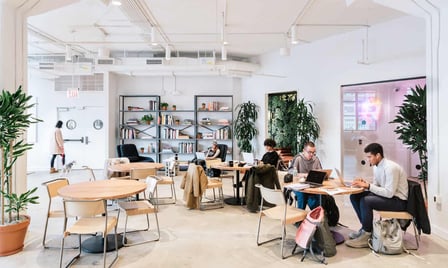Internet --> reality - #372

A few months ago, I referenced the first of these weekly emails, Airspace #1, to introduce the essay in Monoculture #360. Both describes something true at a surface level: everything looks the same because our global culture can make it so; our culture tends to choose global and mono because it can. What's more interesting, and on the original "technopoly" focus of this weekly missive, is the mechanism by which the Airspace or Monoculture has emerged. How does airspace and monoculture happen?
The emergent mechanism is the internet. And our old friend, Kyle Chayka, author of the original Airspace essay, describes at the collected outcome of millions of parallel existences:
Simply existing as a coffee shop isn't enough; the business has to cultivate a parallel existence on the internet, which is a separate skill set entirely. "It almost feels like, you must have a social media acumen, you must be savvy in this area that is adjacent to your business, but not directly embedded in your business, in order to be successful and visible," [coffee shop owner] Walsh continued. That means plenty of tagged photos on Instagram and positive user reviews on the business's listing on Yelp or Google Maps.
Both businesses and people have felt the need, since the late 1990s, to cultivate an online parallel existence. I remember signing up for both endless social media services to syndicate out my lifestyle content and then more than a few services to collect all of the threads and present a "Nathanael's life stream" to the internet. I was proudest when I figured out a way to ensure my Instagram photos were posted automatically to Facebook, to ensure all of my people could see all of my pictures. (The album made the scarily accurate prediction that Facebook would buy Instagram and the predicable joke that the resulting thing would be called Grambook or Instaface.)
The interesting thing isn't the existence we've built online. If you squint at it just right, then you see it not altogether different from the way we appeared to far-off friends in letters or phone calls in previous decades. The interesting thing, and the mechanism we probably didn't expect, is how the online world changed our behavior in the real one. For example, Chayka's essay talks about how the interior design of coffee shops morphed to ensure they looked good on the Internet and then morphed to ensure they stayed on-trend for how similar shops looked across the world.
To court the large demographic of customers moulded by the internet, more cafes adopted the aesthetics that already dominated on the platforms. Adapting to the norm wasn't just following trends but making a business decision, one that the consumers rewarded. When a cafe was visually pleasing enough, customers felt encouraged to post it on their own Instagram in turn as a lifestyle brag, which provided free social media advertising and attracted new customers. Thus the cycle of aesthetic optimization and homogenization continued.
[The letter s has been replaced with a z in the final sentence of that block quote because while the Guardian speaks the King's English, I don't.]
The algorithm presented and expected an aesthetic. To grow their businesses and online presences, coffee shops played by those rules. More personal examples include how both our thinking and our conversational styles are shaped by the podcast hosts we sit with. Or maybe even how some of us write weekly Friday emails in the old blog format, to ensure our friends know what we're thinking, even though our Modblogs and Xangas are long-gone.
We thought we were sharing things on the Internet; we didn't know the Internet was going to tell us what to do. I'm doubtful any of us would've signed up for a social network if, on the sign-up page, it said something like:
- Turn into a person who's the amalgamation of the online brand of all the people you are most jealous of
- Never again will you enjoy a nice moment without thinking of a filter and caption for the share
- Learn to see yourself the way others see you: be engaging enough for a double-tap during an late-night endless scroll session
I'd like to think that no one wants endless, compounding sameness, and that people's souls are more interesting in their uniqueness. Our lives are too beautiful and too messy to fit into the little rectangles and squares of the algorithm. But then, when it comes time to decide how to paint my room's walls, I'm instantly in the algorithm, trying to find an aesthetic that someone else tried first, took photos, and shared. Instead of looking at my space, I'm trying to see if the DIY blogger I found has the sort of aesthetic and life that I'd like to find at the end of the next paint bucket. While the algorithm can give you a clue, there's nothing to replace getting out the paint, putting it on your wall, standing back, and seeing how it looks.
Reading
 The tyranny of the algorithm: why every coffee shop looks the same
The tyranny of the algorithm: why every coffee shop looks the same
From the generic hipster cafe to the ‘Instagram wall’, the internet has pushed us towards a kind of global ubiquity – and this phenomenon is only going to intensify